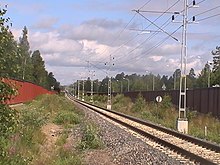This article needs additional citations for verification. (June 2021) |
The Haparanda Line (Swedish: Haparandabanan) is a 165-kilometer (103 mi) long railway line between Boden and Haparanda in Sweden. There is a 3-kilometer (1.9 mi) long section from Haparanda to Torneå, which is on the Finnish side of the Finland–Sweden border. The line is the only Swedish railway to the Finnish border.


The single track line was used exclusively by freight trains between 1992 and 2021, during which time it was necessary to use buses from Luleå to the Haparanda bus station, with onward connections to Kemi in Finland. Passenger service began again on the 1 April 2021, operated by Vy Norrtåg. [1]
History edit
Haparanda Line | ||||||||||||||||||||||||||||||||||||||||||||||||||||||||||||||||||||||||||||||||||||||||||||||||||||||||||||||||||||||||||||||||||||||||||||||||||||||||||||||||||||||||||||||||||||||||||||||||||||||||||||||||||||||||||||||||||||||||||||||
|---|---|---|---|---|---|---|---|---|---|---|---|---|---|---|---|---|---|---|---|---|---|---|---|---|---|---|---|---|---|---|---|---|---|---|---|---|---|---|---|---|---|---|---|---|---|---|---|---|---|---|---|---|---|---|---|---|---|---|---|---|---|---|---|---|---|---|---|---|---|---|---|---|---|---|---|---|---|---|---|---|---|---|---|---|---|---|---|---|---|---|---|---|---|---|---|---|---|---|---|---|---|---|---|---|---|---|---|---|---|---|---|---|---|---|---|---|---|---|---|---|---|---|---|---|---|---|---|---|---|---|---|---|---|---|---|---|---|---|---|---|---|---|---|---|---|---|---|---|---|---|---|---|---|---|---|---|---|---|---|---|---|---|---|---|---|---|---|---|---|---|---|---|---|---|---|---|---|---|---|---|---|---|---|---|---|---|---|---|---|---|---|---|---|---|---|---|---|---|---|---|---|---|---|---|---|---|---|---|---|---|---|---|---|---|---|---|---|---|---|---|---|---|---|---|---|---|---|---|---|---|---|---|---|---|---|---|---|---|
| ||||||||||||||||||||||||||||||||||||||||||||||||||||||||||||||||||||||||||||||||||||||||||||||||||||||||||||||||||||||||||||||||||||||||||||||||||||||||||||||||||||||||||||||||||||||||||||||||||||||||||||||||||||||||||||||||||||||||||||||
The railway from Boden to Haparanda was built in several sections over the course of 17 years. The first segment to be completed was Buddbyn to Niemisel in 1900, followed by the segment Niemisel to Morjärv in 1902. The railway did not reach Lappträsk until in 1910, and the Swedish–Finland border at Karungi on the west bank of Torne River was not reached until 1913.
Karungi was to become a junction, and the railway reaching northward to Övertorneå was built in 1914, followed by the southern Karungi to Haparanda line in 1915. The only open railway connection between Germany and Russia during World War I went here. Lenin traveled here in 1917[note 1] to organise the Russian Revolution. The railway bridge over the Torne River between Haparanda and Tornio was placed in service in 1919. Before that passengers had to walk or use horse carriages the short distance between the cities. In order to cross the river which goes east of Tornio, they had to take a ferry boat, or in the winter use a road on the ice, as the road bridge was built later.
The station building was finished in 1918, and was dimensioned based on the traffic during the war. All international travellers had to change trains here because of the break-of-gauge, and had to go through passport check. During World War II, the traffic was dense again since the Baltic Sea was not safe. It is one of Sweden's largest station buildings, but only used to some extent for rail purposes (since 2021).
The branch line from Morjärv towards Kalix was built in 1961. Traffic between Karungi and Övertorneå was discontinued in 1984, and the line was torn up soon thereafter. In 1986 a more direct route was built between Övermorjärv and Östra Flakaträsk, bypassing the Räktjärv station. The old line along with one bridge was demolished soon after the new shortcut was built; however, the old line is still visible on many Swedish maps.
Passenger traffic ceased in 1992. The connection to the Finnish trains was already broken in 1988 when the Haparanda–Tornio–Kemi trains were discontinued. There was a test with tourist traffic between Boden–Haparanda in the summer of 2000.
During the period 2007 to 2012, the line from Buddbyn (near Boden Central Station[2]) to Morjärv and Kalix was upgraded, and an alternate route from Kalix to Haparanda was built. The line was electrified in the same time.[3] The old line from Morjärv over Karungi to Haparanda was abandoned in 2012. In 2013, the European Train Control System (level 2) signalling system was introduced on the line.[4]
In 2020, Norrtåg applied to start passenger services from Luleå and Boden to Haparanda. Passenger services restarted on the 1st of April 2021, including one weekday round trip to/from Umeå.[5][6] A new railway station was built in Kalix.[7][8]
See also edit
Notes edit
- ^ See the Vladimir Lenin article for more details.
References edit
- ^ "Slow travel through Scandinavia is now easier with this new train line". euronews. 6 April 2021. Retrieved 9 June 2021.
- ^ "Haparandabanan". Järnväg.net. Archived from the original on 3 May 2013. Retrieved 19 November 2010.
- ^ News in Brief Railway Gazette International
- ^ "ETCS goes live to Haparanda". Railway Gazette International. 17 January 2014. Retrieved 1 July 2019.
- ^ Trafikverket (6 July 2020). "Förslag Tågplan 2021". Trafikverket. Retrieved 19 August 2020.
- ^ "Slow travel through Scandinavia is now easier with this new train line". euronews. 6 April 2021. Retrieved 9 June 2021.
- ^ Larsson, Mattias (8 May 2020). "Nya tågplattformar banar väg för persontrafik mellan Luleå och Haparanda". SVT Nyheter (in Swedish). Retrieved 19 August 2020.
- ^ New start for passenger trains in northern Sweden International Railway Journal 24 November 2020
External links edit
Media related to Haparandabanan at Wikimedia Commons